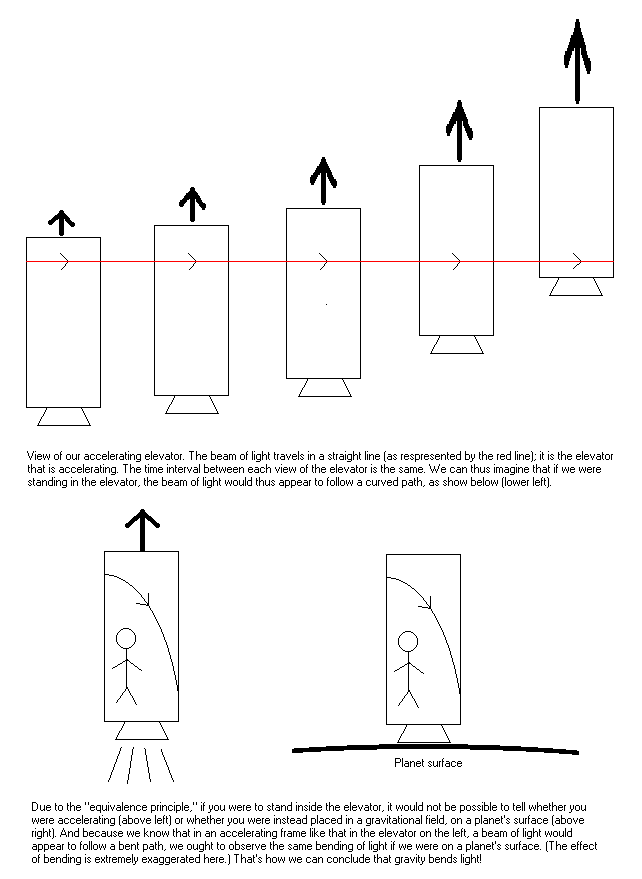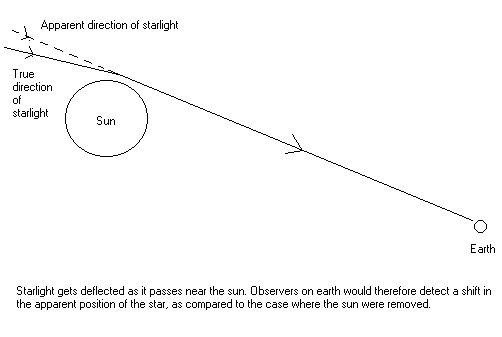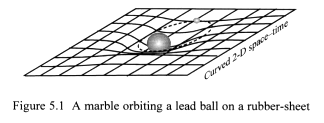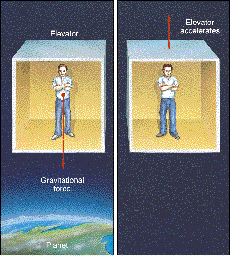Time Travel Research Center © 2005 Cetin BAL - GSM:+90 05366063183 - Turkey / Denizli
General Relativity
The Theory of Gravity
What is
gravity? Most of us know (or think) that gravity is the attractive force
that acts between any two masses. That's what holds us to the surface of the
Earth. But is that all there is to it? Let's consider the following thought
experiments:
Almost everyone has been in an elevator before. We know how we seem to feel
heavier when the elevator is picking up speed as it moves up, and lighter
whenever it is picking up speed while moving down. (Note that during most of
your journey up or down an elevator, when it is moving at a constant
velocity, you don't feel any heavier or lighter. That is because your
acceleration is zero, and therefore there is no additional "increase" or "decrease"
in the magitude of the force the elevator floor exerts on you.) Now, what
happens in the - albeit unfortunate - event that the cable holding the
elevator breaks? We know that the elevator will begin to fall freely under
the influence of gravity, and you would feel weightless.
Then imagine that you are in the same elevator, but now your elevator is
placed far out in deep space, with nothing around for light years. You would
also feel weightless, since this time, there are no large masses around to
attract you gravitationally.
Is there any way to distinguish the two, if in both cases you are trapped in
the elevator, with no windows for you to peep outside, thus making you
oblivious of your surroundings?
Now suppose your elevator is at rest on the Earth's surface. (You are still
trapped.) You are standing on your weight machine, and it reads, say, 120
pounds. Next, suppose that you are back in deep space once again, but this
time, with rocket boosters installed at the base of your elevator. The
thrusters are activated, and you are pushed upwards with a constant force
equal to that of your weight on Earth. Therefore, if you are still standing
on your weight machine, it will read 120 pounds again.
Again, with no windows, is there any way to distinguish between the two
situations?
Albert Einstein in
developing his theory of General Relativity, which he proposed in 1915,
realized this equivalence between gravity and accelerating frames of
reference. (Well, I'm lying. The above situations aren't exactly
indistinguishable. But to observe a noticeable difference between each, you
need a much larger elevator than the ones commonly found in terrestrial
buildings, so for our purposes here, they are indeed indistinguishable.) He
made it the fundamental postulate of his General theory, and discovered,
just as he did when he made the constancy of the speed of light a postulate
of his Special theory, many interesting implications of this "equivalence
principle".
Let's return to our elevator in deep space. If you stand against one of its
walls, and throw an apple in the direction parallel to the floor of the
elevator, the apple would obviously travel in a straight line and hit a
point directly opposite. If, however, you were to activate the thrusters so
that the elevator begins to accelerate "upwards," and you were to throw
another apple, again in the direction parallel to the floor of the elevator.
This time, the apple would follow a curved path as observed from inside the
elevator, hitting a point on the opposite wall closer to the floor than it
was when it first left your hands. This is because the apple, unlike you and
the elevator itself, is not being pushed by the thrusters (since there is no
direct contact between the apple and any part of the elevator during its
motion) while the elevator and you accelerate "upwards". Or, to think of it
another way, if there was a person floating outside the elevator, and he/she
could look inside, he/she would see the apple moving in a straight line
while everything else is accelerating.

A little about velocity, acceleration, and force:
Velocity
is the distance traveled, in a particular direction, by an object in a
unit of time For example, 5 metres per second means 5 metres is transversed
for every second that passes).
Acceleration
is the rate of change of velocity. For instance, g = 9.8 metres per
second per second is the symbol used to denote the acceleration of free fall
- that is, the acceleration that one would experience under the sole
influence of Earth's gravity. In this case, 9.8 metres per second per second
means that if you fall from rest, after 1 second, your velocity would be 9.8
metres per second; after 2 seconds, your velocity would be 9.8 + 9.8 = 19.6
metres per second; after 3 seconds, it will be 19.6 + 9.8 = 29.4 metres per
second, and so on.
Force,
in non-physics language, is simply a push or a pull. But a force can also be
described in terms of the acceleration it produces in an object. That is
related by Newton's second law: Force = Mass of object x Acceleration. It
follows that if we keep the mass of the object constant, then the larger the
force
What if
you were to, instead of throwing an apple, shine a beam of light in the
elevator, pointing it in the direction parallel to the floor of the elevator
while the thrusters are working? By the same arguments used above, it is
only logical that light would also travel a curved path through the elevator
as observed by you since it is really traveling a straight line through
space; it is the elevator and you that is accelerating. (For diagram on the
right, with "snapshots" of our accelerating elevator at various times, the
elevators should really be overlapping each other, since I am trying to show
our elevator's motion against the straight line path taken by light. But for
clearer presentation, I place them side-by-side instead.)
But we have just hypothesized that accelerating frames of reference are
indistinguishable from those under the influence of gravity. That means if
we were to place our elevator back on Earth, or on any massive planet, light
would still have to appear to bend in the same way it did when the elevator
was out in deep space! And that means we have just discovered, like Einstein
did back in the beginning of the 20th century, that gravity bends light.
This is contrary to Newton's law of gravitation, which states that the force
of gravity exists only between objects of mass. Light, consisting of
massless particles called photons, should not be attracted by gravity at all.

Of course, it is perhaps possible that accelerating frames of reference are
indeed distinguishable from those under the influence of gravity, simply by
observing the behavior of light. The one in which light does not bend is in
a gravitational field; the one in which light does bend is simply
accelerating. However, if General Relativity were true, it predicts that
light from a star would be deflected as it passes near the sun. This would
mean that, as observed from the Earth, we would detect a shift in the
apparent position of the star in the sky relative to the background stars (this
is much like why a pencil would appear crooked when placed in water). During
a total eclipse of the sun sometime toward the end of the 1910's (or early
1920's?), such a shift was indeed detected, thus confirming the validity of
General Relativity. Einstein then became a celebrity overnight.
Today, astronomers also observe such light bending phenomenon deep in space:
distant galaxies appear to have bizarre looking objects orbiting around them.
It turns out that these objects are really the "mirages" of bright galaxies,
quasars, etc., located behind them. This phenomenon is known as
gravitational lensing.
General Relativity
Einstein's general relativity applies to frames of reference that are
accelerating with respect to inertial frames. It developed from his
happiest thought - the principle of equivalence: No experiment
can distinguish between a uniform gravitational field and an equivalent
uniform acceleration.
Tests carried out to an accuracy greater than one part in a hundred
million million have shown that there is nothing to distinguish between
a material object's gravitational and inertial mass, and wisp theory
predicts that no experiment on earth can separate the two.
Although the principle upon which it is built is very simple, because of the nature of Einstein's spacetime, the theory becomes complex. It predicts that mass and energy are responsible for the curvature of spacetime, and gravitational effects are a consequence of this. The gravitational force in this sense is regarded as fictitious.
In this spacetime, light follows paths of shortest distance between
points geodesic lines, and the rules of Euclidean geometry breakdown
straight-line paths become curved, etc.

As it is practically impossible to visualise what three-dimensional spacetime would look like, simplified models are used. Figure 5.1 shows a heavy mass (lead ball) curving two-dimensional spacetime (rubber-sheet). A smaller mass (marble) is seen moving on this surface, orbiting the larger mass. This image helps us to understand the process that causes the gravitational effect. However, it only represents two-dimensional spacetime which we view in three-dimensional space. This does not explain the true cause of gravity, as it is an abstract idea that arises from the spacetime concept.
The first success of Einsteins theory was demonstrated by the correct prediction of a small anomaly in the precession of the perihelion of the planet Mercury that Newtons formula failed to predict of 43 seconds of arc per century.
Further tests confirm general relativity. In 1919 Arthur Eddington
carried out tests during a total solar eclipse and showed that light
gets deflected as it passes close to the surface of the Sun.
Ether and General Relativity
It is a simple matter to explain general relativity in terms of the ether, and in doing so it is possible to show what causes of the effects that general relativity discovered. We do this by applying wisp principles directly to the formulas of general relativity.
What causes clocks to run slow in a gravitational field?
In free space, wisps are in closer together and the binding force is at its greatest strength. And so, the forces that drive the inner workings of stationary clocks in free space are at full strength, and time runs at its absolute rate - unaffected by dilation effects. Closer to large bodies, wisp space is rarefied because wisps are forced apart by curvature, and the "horizontal" spherical tension force is weakened. The forces that drive the inner workings of clocks in gravitational fields are weaker, and so they run slower. These effects would no be detected by local observers, as they too experience dilation effects, which would mask the changes. The only force that increases the closer it gets to the body is the gravitational force, which is caused by the radial compression force.
Wed, 2/9 - More gravity, curved space
There are three types of curvature: flat, positive (a sphere is an example), and negative (the neck of a beer bottle is an example).
CURVATURE is determined by drawing two perpendicular geodesics through a point. The radius of curvature is determined for each of these geodesics by fitting a sphere to those lines.
CURVATURE is the product of the inverse of the radii of curvature.
Curvature = 1/r X 1/r. On a flat surface the radius of curvature is infinite and the inverse is zero.
Flat Space: Curvature =0. A cone and a cylinder are also with zero curvature and are therefore flat.
CURVATURE >1 positive curvature
CURVATURE <1 negative curvature
Positive curvature means geodesices will eventually intersect. Negative curvature means that they will never cross.
In the case of beer bottle or the horn of a trumpet, one geodesic curves in a positive direction and the other curves in a negative direction, hence the product is negative.
In the case of the INTERIOR of a sphere, such as the planetarium, each geodesic curves downward and is negative. But the product of two negative numbers is positive, so the curvature is positive.
PRINCIPLE OF EQUIVALENCE: Consider an elevator in intergalactic space, far, far from any mass. When the elevator is at rest or moving at the constant speed the persons inside is weightless. But if the elevator picks up speed and accelerates constantly at 980 cm/sec/sed, the person will fall to the floor and weight. In fact his experiences will be precisely identical to those within a similar elevator sitting on the surface of the earth. Einstein proposed this Principle of Equivalence: all experiences of gravity are identical to those of acceleration. In both cases, object will FALL to the floor with the same acceleration, regardless of their mass. In both cases the light sent horizontally will be curved downward.
If a clock is on the floor of the accelerating elevator sending out pulses, the pulses will be pulled apart and the clock will appear to tick slower...thus time will appear to slow down. And time will slow down in a gravitational situation. The faster the acceleration, the greater the apparent curving of light, the greater the curvature of space time, and the greater the slowing down of time.
If a light is on the floow its waves will be pulled apart and it will appear redder. The greater the curvature of the beam of light, the greater the "gravitational" red shift. This idea led Einstein to propose that light will be reddened on stars, or best of ball, a dense, compressed white dwarf. Astronomers looked and found the gravitational red shift, just as he had predicted. What a wonderful guy!
Curvature=1/r1 x 1/r2, where r1 and r2 are the radius of curvature of 2 perpendicular geodesics.
P. 505 - Einstein's Principle of Equivalence - one cannot tell the difference between an accelerated frame of reference (like an elevator) and gravity.

Mon, 2/7 - Black holes and the Triumph of Gravity
We dopped ball bearings and timed them in class.
gravitational acceleration = 2 times the distance/time squared
Review: what is "mass"? Two kinds of mass, which one can experience: inertial mass and gravitational mass. Einstein showed that gravitational mass does not exist.
Falling into a black hole: Because of geodesics that have different curvatures, one's head is gradually separated from one's feet. As the result of such stretching one is stretched and squeezed into a bloody, red noodle before one crosses the event horizon of black hole with a mass of one solar mass.
Such stretching also results in the oblate shape of the moon. And most interestingly, it also results in two ocean tides on the earth (ON OPPOSITE SIDES OF THE EARTH), due to geodesics that are shaped by the moon.
The larger universe is full of black holes, both large and small, and curved space-time.
Cygnus X-1 is a binary system with a period of 5.6 days and an ordinary star with a mass of 25 solar mass and an apparent black hole with a mass of 10 solar masses. It produces flickering x-rays which indicate that the black hole as a radius of 150 km or less. A black hole with a mass of 10 solar masses has a radius of 30 km.
Pg 541. The center of the galaxy has a hot spot, known as Sagittarius A, which may be a black hole with a mass of 1-2 million solar masses. It also Pg 538. The gravitational lensing caused by the curvature of space-time by a faint star causes occasional observed brightenings, which not only reveal the presence of faint (otherwise unobservable stars) but also demonstrates clearly curvature of space-time Pg 578; Certain galaxies known as Seyfert galaxies show great bursts of light. These may be due to a collection of stars falling into black holes in their centers. These black holes may contain billions of solar masses within them.
Pg 584: The brightest object in the universe, quasars may be powered by huge black holes in their centers, into which stars fall and give off energy just before crossing the event horizons.
Pg 593:The doubling of quasars is firm evidence of curvature of space time.
Pg 594. The spectacular Einstein cross is another example of gravitational lenses and curved space-time
Pg 596. Deep in space, gravitational lenses causes arcs of distorted galaxies in the distance. Figure 25.24 is an amazing demonstration of how space acts like a distorting lens because of its curvature.
Pg 620 Curved space may represent curved- space time. The same situation with the interior angles of a triangle that we presented in class is discussed, for a triangle with the sum of interior angles of 270 degrees covering 1/8 of a sphere. The following chart shows geometry,
| flat | 180 | 1 |
| positively curved | >180 | none |
| negatively curved | <180 |
Hiçbir yazı/ resim izinsiz olarak kullanılamaz!! Telif hakları uyarınca bu bir suçtur..! Tüm hakları Çetin BAL' a aittir. Kaynak gösterilmek şartıyla siteden alıntı yapılabilir.
The Time Machine Project © 2005 Cetin BAL - GSM:+90 05366063183 -Turkiye/Denizli
Ana Sayfa /
index /Roket bilimi /![]() E-Mail /CetinBAL/Quantum Teleportation-2
E-Mail /CetinBAL/Quantum Teleportation-2
Time Travel Technology /Ziyaretçi Defteri /UFO Technology/Duyuru